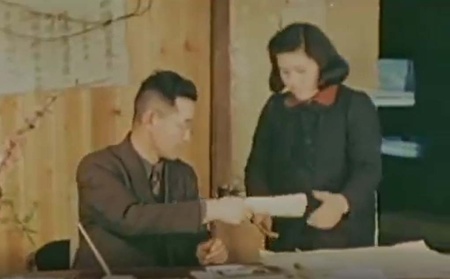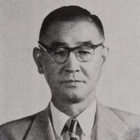
In my previous article, I mentioned that in April 1946, almost eight months after the atomic bomb was dropped on Hiroshima, Kato Shinichi appears in footage of Hiroshima city taken by the U.S. military. The filming was reported in the Chugoku Shimbun newspaper at the time.
The April 16th issue of the same year had the headlines "Symbol of Recovery" and "Head Office Makes its National Presentation with Natural Color Film," along with a photo of a man believed to be Kato sitting at a desk. The caption read, "The photo shows a scene from inside the headquarters editorial department."
To quote the article verbatim:
"In order to make a film about war-torn Japan, MacArthur's headquarters organized an army film unit and mobilized special trains, capturing Nagasaki City and other parts of Kyushu on full-color film, but in the past month in Hiroshima they even mobilized fire ladders to film the burnt ruins, and on a recent Sunday they traveled to the cherry blossoms of Miyajima, and recently they traveled as far as Kure City and Shikoku, and within a few days they will be moving to Okayama City. In Hiroshima, they covered 15,000 feet of land including the city hall and hospital, and chose the headquarters of a newspaper company, which was the first to be restored in the disaster area, as a representative example of the entire country, and filmed the process from reporting to the printing of the newspaper, and will soon be able to meet movie fans from all over America."
Furthermore, in the paper's earlier edition dated March 29th, an article with a photo headed "Hiroshima Remains Heading to America" stated, "A film captures the collection of the remains of those who died in the war as a result of the atomic bomb at the Hiroshima Municipal Remains Mortuary."
He also serves as chairman of the labor union.
At that time, Kato was the deputy editor-in-chief, the number two person in the editorial department. At the same time, about two months before the US military filming, at the founding meeting of the Chugoku Shimbun Employees Union, Kato was elected as the first union chairman. Soon after, he joined the Japan Newspaper Workers' Union, which was the first industrial single-industry union with individual membership.
After the war, as the wave of democratization spread rapidly in Japan, the movement for employees to form unions accelerated at Japanese newspapers. The Chugoku Shimbun was no exception, and a union was formed, but what does it mean that the chairman is a company executive such as the deputy editor-in-chief, or someone of a similar rank?
While it is hard to imagine today, at the time such dual roles were common at the Chugoku Shimbun and other companies. It also seems to have been related to the relationship between the company's labor union and the union at the time the union was formed, as well as Kato's own character, who acted with a sense of honor.
According to Masami Nishimoto, a special editorial committee member for the Chugoku Shimbun who is an expert on the issue of immigrants from Hiroshima and the atomic bomb, the union at the time was not hostile to the company, but it was not a government-controlled union either. On the other hand, there was a critical stance towards being an owner-managed company.
"That's why the union recommended Kato, who had returned from the United States, knew about democracy, and had experience dealing with the occupying forces," says Nishimoto.
A revolutionary even in his old age
In addition, Tetsuo Murakami, who was a prolific editorial writer when Kato was deputy editor-in-chief, wrote about Kato Shinichi's character in his book "Nagare" (published in 1954) under the heading "Hot-blooded," tracing half of his life. Regarding his becoming union chairman after the war, he said the following:
"After the war, I became deputy editor-in-chief for a time, and then when the employees' union was formed, I was elevated to the position of its first head. Because I was well versed in America around this time, I was expected to become editor-in-chief at the time, but rather than gaining a position for myself, I agreed to become union head in order to meet the expectations of my employees."
From this, it can be inferred that Kato accepted the position of union chairman because he was recommended to do so for the sake of the general employees, rather than for the sake of promotion or status within the company. Since Murakami was also critical of owner-management at the time, he may have appreciated Kato's actions even more.
However, Kato had acted against management in the past. Before the war, when he was a reporter for the Rafu Nichibei in Los Angeles, there was a conflict between the president and employees of the sister paper Nichibei in San Francisco. Kato stepped in and offered to mediate between the two sides, but he ended up quitting the company after finding the company's response insincere.
Murakami has the following assessment of Kato's personality and his achievements as union chairman:
"He has always had a hot-blooded nature, and even as he grew older, his revolutionary spirit continued to burn brightly. Far from simply turning the union into a government-sponsored organization, he was well-versed in the most outrageous ways to engage in violent struggles, and there were more than a few instances when management was left dumbfounded. The Chugoku Shimbun newspaper was the second newspaper and communications company in the country to conclude a labor agreement. Even going forward, he was a man of impressive skill and aptitude."
Once again, Kato's words and actions show their power. This too may be an American training.
Kato demonstrated his skills as union chairman, but the Chugoku Shimbun union was also changing due to the power of the Communist Party, which was a nationwide trend, and Kato's position became delicate. Meanwhile, as the growing labor movement shifted from political struggle to economic struggle, in August 1948 the Chugoku Shimbun branch joined the All Japan Newspaper Workers' Union and went on an indefinite strike in December to demand funds to carry the year through. Around this time, Kato was transferred to deputy director of the Cultural Affairs Bureau.
From this time onwards, Kato's position within the union and the company seems to have been unstable. Murakami explains Kato's time from this point until he left the Chugoku Shimbun as follows:
"Meanwhile, Nakai Shoichi (a social activist and aesthetician) became the deputy director of the National Diet Library, and he was also chosen to succeed him as chairman of the Hiroshima Prefectural Labor Culture Association. However, the vanguard of the labor movement began to adopt Communist tactics, and companies began to draw a clear line between them and union members who were no longer eligible for the department manager level or above. Kato found himself in an uneasy position. So in April 1949, at the request of Governor Kusunoki, he became the first chairman of the Hiroshima Prefectural Public Relations Committee..."
This alone is ambiguous, but the words "it's itchy on the buttocks" suggest that Kato had somehow become uncomfortable with the union or the company. Thus, Kato left the Chugoku Shimbun. However, Kato's abilities were highly regarded. At the request of Kusunoki Tsuneo, the first popularly elected governor of Hiroshima Prefecture, Kato became the first chairman of the Hiroshima Prefecture Public Relations Committee.
(Titles omitted)
© 2021 Ryusuke Kawai






